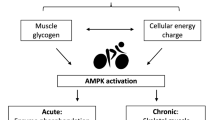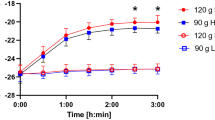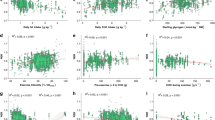Abstract
To provide guidelines on the correct application of the acetate recovery factor in metabolic research, we investigated the influence of exercise intensity and infusion protocol on [1,2-13C]acetate label recovery during exercise. Eight cyclists were studied during [1,2-13C]acetate infusion for 1 h at rest followed by three 30-min stages of cycling exercise at a workload of 40, 55 and 75% maximal workload (W max), respectively (protocol 1). Four cyclists were subsequently studied following [1,2-13C]acetate infusion in three separate trials while cycling at the same workloads but in the absence of any pre-exercise infusion period (protocol 2). Finally, we observed the cyclists during [1,2-13C]acetate infusion at a 40% W max workload after 4 h of pre-exercise infusion (protocol 3). Acetate recovery increased from 13.7 (0.4)%, after 1 h of rest, to a plateau value of 75.1 (2), 91.2 (0.7) and 101 (2)% during exercise at 40, 55 and 75% W max workloads, respectively. In protocol 2, without prior infusion time, fractional label recovery was substantially lower at each separate workload. In contrast, when applying an extensive pre-exercise infusion period of 4 h, acetate recovery rates were substantially increased compared to the values observed in protocols 1 and 2 during exercise at a 40% W max workload. In conclusion, in contrast to resting conditions, acetate recovery reaches a plateau value during exercise. Though this plateau value is repeatedly used to correct for label recovery in various exercise studies, our data clearly show that acetate label recovery during exercise not only depends on the exercise intensity but also on the applied infusion protocol. Therefore, theoretical acetate recovery factors taken from previous literature are not generally applicable.




Similar content being viewed by others
References
Baurle W, Brosicke H, Matthews DE, Pogan K, Furst P (1998) Metabolism of parenterally administered fat emulsions in the rat: studies of fatty acid oxidation with 1-13C- and 8-13C-labelled triolein. Br J Nutr 79:381–387
Gibala MJ, MacLean DA, Graham TE, Saltin B (1997) Anaplerotic processes in human skeletal muscle during brief dynamic exercise. J Physiol (Lond) 502:703–713
Irving CS, Wong WW, Shulman RJ, Smith EO, Klein PD (1983) 13C Bicarbonate kinetics in humans: intra- vs. interindividual variations. Am J Physiol 245:R190–R202
Kuipers H, Verstappen FT, Keizer HA, Geurten P, van Kranenburg G (1985) Variability of aerobic performance in the laboratory and its physiologic correlates. Int J Sports Med 6:197–201
Leijssen DPC, Elia M (1996) Recovery of 13CO2 and 14CO2 in human bicarbonate studies: a critical review with original data. Clin Sci 91:665–677
Metges CC, Kempe K, Wolfram G (1994) Enrichment of selected serum fatty acids after a small oral dosage of (1-13C)- and (8-13C)triolein in human volunteers analysed by gas chromatography/combustion isotope ratio mass spectrometry. Biol Mass Spectr 23:295–301
Mittendorfer B, Sidossis LS, Walser E, Chinkes DL, Wolfe RR (1998) Regional acetate kinetics and oxidation in human volunteers. Am J Physiol 274:E978–E983
Pouteau E, Maugere P, Darmaun D, Marchini JS, Piloquet H, Dumon H, Nguyen P, Krempf M (1998) Role of glucose and glutamine synthesis in the differential recovery of 13CO2 from infused [2-13C] versus [1-13C]acetate. Metabolism 47:549–554
Sahlin K, Jorfeldt L, Henriksson KG, Lewis SF, Haller RG (1995) Tricarboxylic acid cycle intermediates during incremental exercise in healthy subjects and in patients with McArdle's disease. Clin Sci 88:687–693
Schrauwen P, van Aggel-Leijssen DPC, Lichtenbelt WDV, van Baak MA, Gijsen AP, Wagenmakers AJM (1998) Validation of the [1,2-13C]acetate recovery factor for correction of [U-13C]palmitate oxidation. J Physiol (Lond) 513:215–223
Schrauwen P, Blaak EE, Van Aggel-Leijssen DP, Borghouts LB, Wagenmakers AJ (2000) Determinants of the acetate recovery factor: implications for estimation of [13C] substrate oxidation. Clin Sci 98:587–592
Sidossis LS, Coggan AR, Gastaldelli A, Wolfe RR (1995a) A new correction factor for use in tracer estimations of plasma fatty acid oxidation. Am J Physiol 269:E649–E656
Sidossis LS, Coggan AR, Gastaldelli A, Wolfe RR (1995b) Pathway of free fatty acid oxidation in human subjects: implications for tracer studies. J Clin Invest 95:278–284
Tounian P, Schneiter P, Henry S, Tappy L (1996) Effects of infused glucose on glycogen metabolism in healthy humans. Clin Physiol 16:403–416
Trimmer JK, Casazza GA, Horning MA, Brooks GA (2001) Recovery of 13CO2 during rest and exercise after [1-13C]acetate, [2-13C]acetate, and NaH13CO3 infusions. Am J Physiol 281:E683–E692
van Hall G (1999) Correction factors for 13C-labelled substrate oxidation at whole-body and muscle level. Proc Nutr Soc 58:979–986
van Hall G, van der Vusse GJ, Soderlund K, Wagenmakers AJ (1995) Deamination of amino acids as a source for ammonia production in human skeletal muscle during prolonged exercise. J Physiol (Lond) 489:251–261
Wolfe RR, Jahoor F (1990) Recovery of labeled CO2 during the infusion of C-1- vs C-2-labeled acetate: implications for tracer studies of substrate oxidation. Am J Clin Nutr 51:248–252
Author information
Authors and Affiliations
Corresponding author
Rights and permissions
About this article
Cite this article
van Loon, L.J.C., Koopman, R., Schrauwen, P. et al. The use of the [1,2-13C]acetate recovery factor in metabolic research. Eur J Appl Physiol 89, 377–383 (2003). https://doi.org/10.1007/s00421-003-0810-x
Accepted:
Published:
Issue Date:
DOI: https://doi.org/10.1007/s00421-003-0810-x




